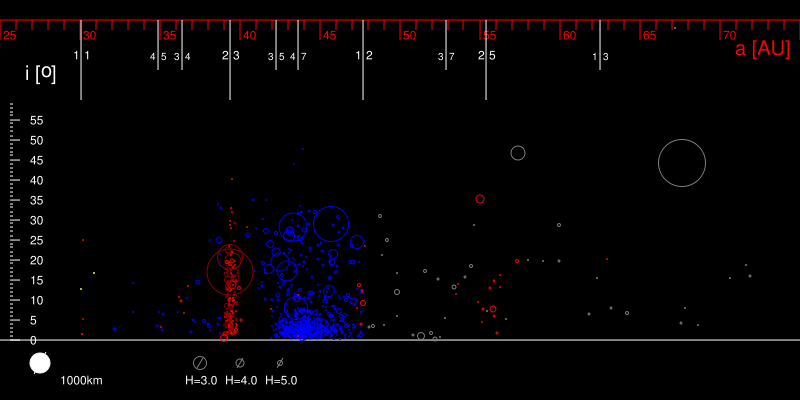Image:TheKuiperBelt 75AU All.svg
From Wikipedia, the free encyclopedia
- Image
- File history
- File links

TheKuiperBelt_75AU_All.svg (800 × 400 pixel, file size: 66 KB, MIME type: image/svg+xml)
|
|
This is a file from the Wikimedia Commons. The description on its description page there is shown below. |
|
|
Contents |
Summary
(voir plus loin pour la description en français) Distribution of Kuiper belt objects' orbits. Objects in resonance are plotted in red (Neptune trojans 1:1, plutinos 2:3, twotinos 1:2,…). Confirmed plutinos are in dark red. Classical objects are plotted in blue. Scattered disk objects (not members of the Kuiper Belt) are shown in grey for reference.
Generated by a program written by Eurocommuter.
Main graph
The position of an object represents
- its orbit’s semi-major axis a in AU (horizontal axis)
- orbit’s inclination i in degrees (vertical axis).
The size of the circle illustrates the object’s size relative to others. For a few large objects, the diameter drawn represents the best current estimates. For all others, the circles represent the absolute magnitude of the object. The eccentricity of the orbit is shown indirectly by a segment extending from the left (perihelion) to the aphelion to the right. In other words, the segment illustrates the variations of the object's distance from the Sun. Objects with nearly circular orbits will show short segments while highly elliptical orbits will be represented by long segments.
Main resonances with Neptune are marked with vertical bars; 1:1 marks the position of Neptune’s orbit (and its Trojan asteroids), 2:3 marks the orbit of Pluto (and its moons) etc. Shorter white bars mark minor resonances.
Data source
MPCORB database as of Feb 14th, 2006, except for resonant orbit classification. Minor Planet Circular 2005-X77 used instead.
| Description |
Distribution of TNO. |
|---|---|
| Source |
Plotted by a program written by the User:Eurocommuter |
| Date |
02 February 2006; last update 14 Sep 2006 |
| Author |
User:Eurocommuter |
| Permission |
see Licence tag |
Description en français
La distribution des objets de la Ceinture de Kuiper. Les objets en résonances sont montrés en rouge, les objets classiques en bleu. Les objets épars qui font pas partie de la Ceinture, sont montrés en gris.
Graphe généré par un programme écrit par Eurocommuter.
Graphe principal
La position d’un objet représente
- le demi axe majeur (rayon moyen) de son orbite a en au (unité astronomique, l'axe horizontal)
- l’inclination de son orbite i en degrés (axe vertical).
Le diamètre du cercle montre la taille relative de l’objet aux autres. Pour quelques grands objets, le diamètre représente la meilleure estimation connue. Pour tous les autres, le diamètre du cercle représente la magnitude absolue de l’objet.
Les positions des résonances avec Neptune sont marqués par des traits verticaux; 1:1 marque la position de l’orbite de
Neptune (et ses Troyens), 2:3 marque l’orbite de Pluton (et ses lunes) etc.
Source des donnés
La base de donnés MPCORB au 14 Février 2006 sauf pour la classification des orbites résonantes où le Minor Planet Circular 2005-X77 a été utilisé..
Licensing
|
File links
- Kuiper belt
- Clearing the neighbourhood
